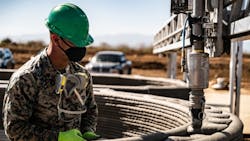DoD Forming Large 3D-Printed Buildings
Three-dimensional (3D) printing is usually associated with microstructures such as electronic packaging, but the U.S. Department of Defense (DoD) is finding ways to use the advanced technology to erect barracks for the troops. The Defense Innovation Unit (DIU) is using 3D printing as part of a project to erect three transient training barracks within 10 months, each larger than 5700 ft.2 The barracks will be the first 3D-printed structures that comply with the DoD’s new Unified Facilities Criteria (UFC) for additive concrete construction.
As U.S. Army Lieutenant General Doug Gabram, commander of U.S. Army Installation Management Command, explained, this use of 3D printing and additive manufacturing technology has many benefits for the armed forces.
“Constructing facilities using this cutting-edge technology saves labor costs, reduces planning time, and increases the speed of construction of future facilities," said Gabram. “We are looking at other ways to use this innovative technique for rapid construction of other types of facilities beyond barracks.”
Previous UFC versions did not include specifications for 3D-printed concrete wall systems. As a result, any construction firms bidding on construction projects could not apply 3D printing for buildings. But the change to UFC requirements by the DoD's Structural Discipline Working Group, working with the U.S. Army Engineer Research and Development Center and the DIU, makes the transition of additive-manufacturing technology possible for the armed forces.
Construction of the barracks is being performed by construction technology company ICON (Austin, Texas), which has previously worked for the U.S. Marine Corps. The barracks are being constructed (see figure) with ICON's proprietary Lavacrete material, a form of concrete with compressive strength of 2,000 to 3,500 lbs/ft.2
About the Author
Jack Browne
Technical Contributor
Jack Browne, Technical Contributor, has worked in technical publishing for over 30 years. He managed the content and production of three technical journals while at the American Institute of Physics, including Medical Physics and the Journal of Vacuum Science & Technology. He has been a Publisher and Editor for Penton Media, started the firm’s Wireless Symposium & Exhibition trade show in 1993, and currently serves as Technical Contributor for that company's Microwaves & RF magazine. Browne, who holds a BS in Mathematics from City College of New York and BA degrees in English and Philosophy from Fordham University, is a member of the IEEE.
